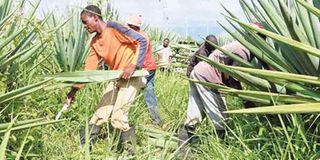Sisal prices continue to fall

Men harvest sisal. Two years before 2016, sisal fibre prices were increasing at an average of 15 per cent annually, but started declining in April 2018 as demand fell. PHOTO | FILE
What you need to know:
- The global price for sisal slightly fell in August this year in the world market following the decline in price of the product, the Bank of Tanzania (BoT) report has shown.
Dar es Salaam. Sisal fibre prices declined in August this year, following a decrease in the world market, a new report has shown.
According to economic review for September by the Bank of Tanzania (BoT), the price of one kilo fell to $1.70 during the year to August 31, 2018 from $1.71 in the correspondent month in 2017.
The declining trend in prices started in April 2018 due to the fall in the global demand.
Two years prior to 2016, prices were increasing at an average of 15 per cent annually as demand was high. Tanzania is the world second largest sisal producer after Brazil while Kenya is the third.
Brazil produces 120,000 tonnes of sisal, Tanzania 35,000 tonnes and Kenya 25,000 tonnes.
Sisal fibre is exported to China, Saud Arabia, Spain, India, Egypt, Japan, Kenya, Nigeria, Libya and Morocco. Tanzania aims at increasing sisal production to 53,237 tonnes in 2020/21 from the current average of 34,589 tonnes.
The crop was introduced in Tanzania in the late 19th century by the German East Africa Company.
At the time of independence in 1961, Tanganyika was the largest exporter of sisal in the world and the industry employed over 1 million farmers and factory workers, according to estimates.
Its production began to decline due to the drop in world prices as synthetic nylon substitutes became more popular.



